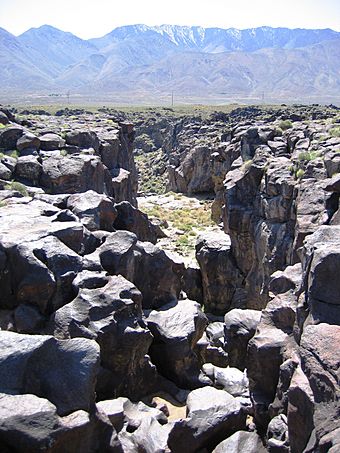Fossil Falls facts for kids
Quick facts for kids |
|
|
Fossil Falls Archeological District
|
|

Fossil Falls
|
|
| Nearest city | Little Lake, California |
|---|---|
| Area | 750 acres (300 ha) |
| NRHP reference No. | 80004492 |
| Added to NRHP | July 09, 1980 |
The Fossil Falls is a really cool natural spot in the Coso Range of California, USA. It's not a waterfall with flowing water today. Instead, it's a unique area with smooth, dark rocks shaped by ancient water and volcanoes.
Long ago, volcanoes were active in the mountains. Also, melting ice from glaciers in the nearby Sierra Nevada mountains created a lot of water. Both of these things helped create the amazing shapes you see at Fossil Falls. You can find Fossil Falls near the town of Little Lake. It's just a short drive off US 395. Look for signs to Fossil Falls near a red hill called "Red Hill."
Contents
How Fossil Falls Formed
During the last ice age, huge sheets of ice, called glaciers, covered parts of the Sierra Nevada mountains. As these glaciers melted, their water flowed into big lakes. One of these was Owens Lake, which fed the Owens River.
The Owens River used to flow through the area where Fossil Falls is now. But volcanoes in the Coso Volcanic Field erupted and sent hot lava flowing across the land. This lava blocked the river's path many times. Each time, the river had to find a new way to flow.
The falls formed when the river was forced to flow over a hard, dark volcanic rock called basalt. Over thousands of years, the rushing water polished and reshaped this rock. This created the unique and smooth shapes you see today.
Volcanic Activity and Water Flow
The lava flows at Fossil Falls are all made of basalt rock. Some lava came from the northeast, and later, younger lava came from Red Hill. You can see Red Hill from Fossil Falls. These lava flows happened between 400,000 and 10,000 years ago.
During this time, glacial meltwater continued to flow through Fossil Falls. This water smoothed the basalt rock. The most recent shaping of Fossil Falls happened about 20,000 to 10,000 years ago. This was caused by the youngest glacial runoff from the Sierra Nevada mountains.
Mysterious Potholes
If you look closely at the basalt rock, you'll see small holes where gas bubbles were trapped in the lava. But you'll also find much larger, perfectly round holes. These are called potholes.
Scientists think that Red Hill, the nearby volcano, threw out small, hard rocks. These rocks fell into the river at Fossil Falls. As the water rushed past, it created swirling currents, like tiny whirlpools. These powerful currents picked up the hard rocks and spun them around. This action drilled the round potholes into the basalt rock over a very long time.
Waterfalls Moving Upstream
Like many waterfalls, Fossil Falls didn't always look the way it does now. It actually started further downstream and slowly moved its way upstream. This happens because the force of the water falling over the edge wears away the rock underneath. This process is called plunge-pool erosion. As the rock at the bottom wears away, the waterfall's edge collapses, and it moves backward, or upstream, and often gets taller.
Native Americans at Fossil Falls
Long, long ago, groups of Native Americans lived in this area. They were here as early as 10,000 to 20,000 years ago. They set up camps along the river, which is now dry. They gathered plants and hunted large animals that lived there.
Around 6000 BCE, the weather became very dry. This forced many of these early people to leave the region. But as the climate became more moderate around 4000 BCE, Native Americans started to return. They developed new ways to live and use the resources found in the desert.
This way of life continued until the 1800s. That's when the Little Lake Shoshone tribe first met Europeans.
Tools and Protection
You might find small pieces of a dark, glassy rock called obsidian in the area. Native Americans camped near Fossil Falls and chipped obsidian from the Coso Mountains to make their tools. Obsidian was very important for making sharp knives and arrowheads.
Because of its history and the artifacts found there, the Fossil Falls Archeological District is listed on the National Register of Historic Places. This means it's a very important historical site. The Bureau of Land Management protects Fossil Falls as an "Area of Critical Environmental Concern." This means it's against the law to remove any Native American artifacts from the area. It's important to leave them where they are so everyone can learn about the past.




